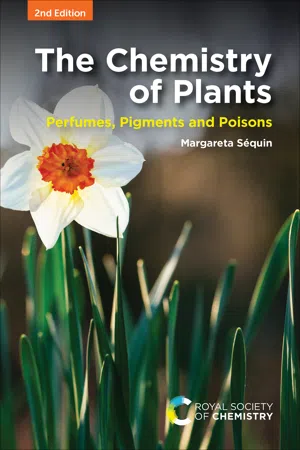
The Chemistry of Plants
Perfumes, Pigments and Poisons
Margareta Séquin
- 206 Seiten
- English
- ePUB (handyfreundlich)
- Über iOS und Android verfügbar
The Chemistry of Plants
Perfumes, Pigments and Poisons
Margareta Séquin
Über dieses Buch
Why are some plants so important to humans? The chemistry of the plants has a lot to do with it!
The plant world offers a fascinating way to explore basic chemistry concepts. The spectacular variety of colors, fragrances and other characteristics of plants are driven by the seemingly subtle differences in the structure and properties of organic compounds. Well-known flowers, like daffodils and narcissus, are examples of plants that provide ample perfumes, pigments and poisons as part of their intricate and fascinating chemistry.
This second edition retains it accessibility, expanding on the first edition and combining scientific concepts with colorful pictures and stories in simple, clear language. Readers will find introductory information on some chemistry and plant biology. This prepares them for the more complex chemical structures that compose plant substances, many of them of vital importance to humans. The final chapter has been expanded, in particular the sections on medicinal plants and on genetic modification. The end-of chapter references have been thoroughly updated with articles, books, and relevant websites that illustrate the topics discussed.
Dr Margareta Sequin, an organic chemist and plant enthusiast, has taught popular undergraduate college level courses on plant chemistry to non-chemistry majors and has led numerous field seminars for the general public. The comments and questions from these audiences and the topics that especially captured people's interest have greatly shaped this book.
The Chemistry of Plants addresses an audience with little previous chemistry knowledge, but will appeal to the expert reader looking for an understanding of more complex plant compounds. It can be used both as a text to introduce organic chemistry as it relates to plants and as a text of reference for more advanced readers.
Häufig gestellte Fragen
Information
1.1 Introduction

1.2 Plants and Their Elements
| Element | Some major functions | Sources |
| Macronutrients | ||
| Carbon | Essential component of organic compounds | CO2 |
| Oxygen | Major component of organic compounds | H2O, O2 |
| Hydrogen | Major component of organic compounds | H2O |
| Nitrogen | Component of nucleic acids, proteins, chlorophyll, alkaloids | NO3−, NH4+ |
| Sulfur | Component of some amino acids, proteins, coenzymes | SO42− |
| Phosphorus | Component of nucleic acids, ATP, phospholipids, coenzymes | H2PO4−, HPO42− |
| Potassium | For osmotic balance, operation of stomata; enzyme activator | K+ |
| Calcium | Required for formation and stability of membranes; activation of some enzymes | Ca2+ |
| Magnesium | Component of chlorophyll; activates many enzymes | Mg2+ |
| Micronutrients | ||
| Iron | In chlorophyll synthesis, activates some enzymes | Fe3+, Fe2+ |
| Chlorine | For ion balance; in water-splitting process of photosynthesis | Cl− |
| Boron | Cofactor in chlorophyll synthesis | H2BO3− |
| Manganese | Activates enzymes; in chlorophyll synthesis | Mn2+ |
| Copper | Involved in redox reactions | Cu2+, Cu+ |
| Zinc | Activates enzymes | Zn2+ |
| Molybdenum | Essential for nitrogen fixation | MoO42− |
| Nickel | Cofactor for enzymes in nitrogen metabolism | Ni2+ |